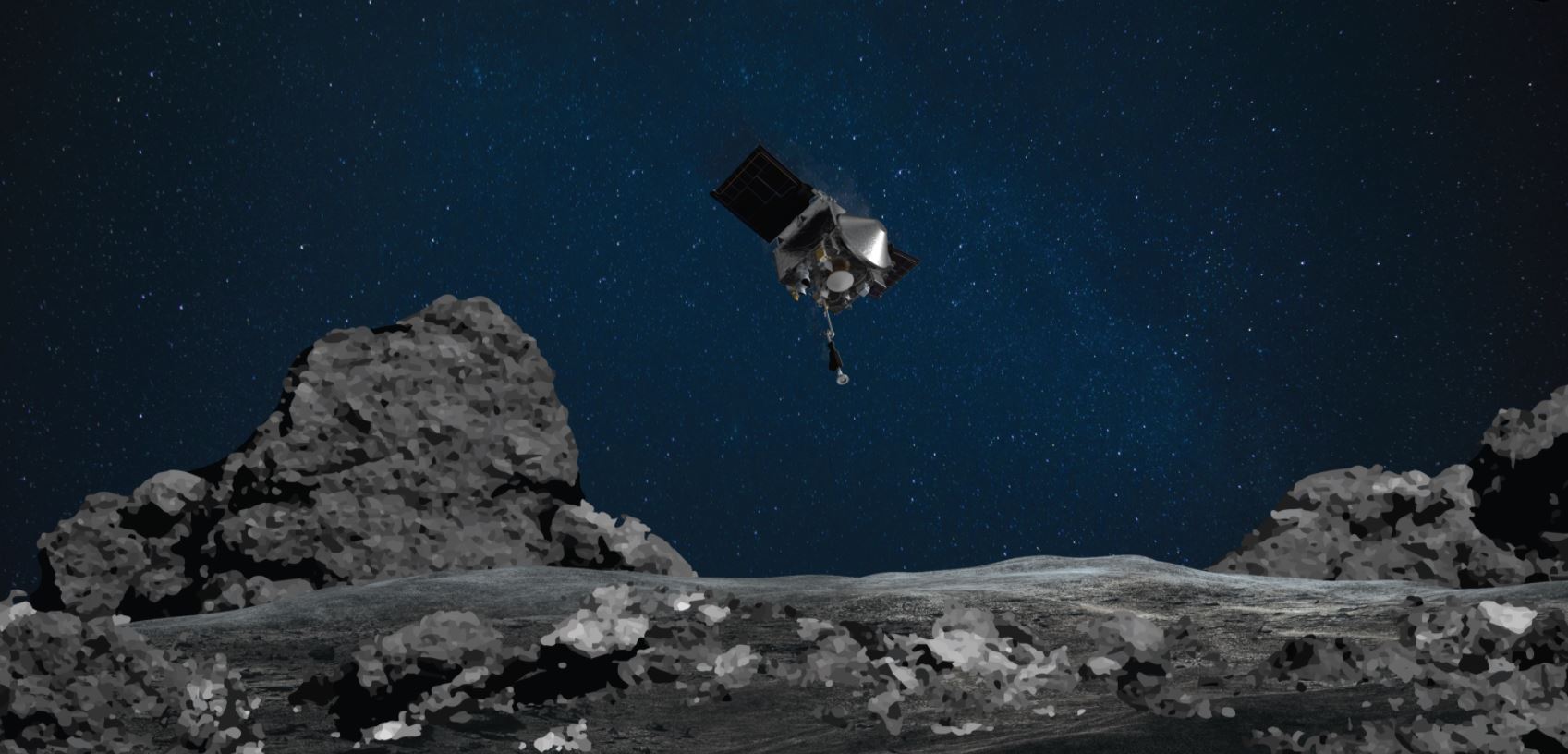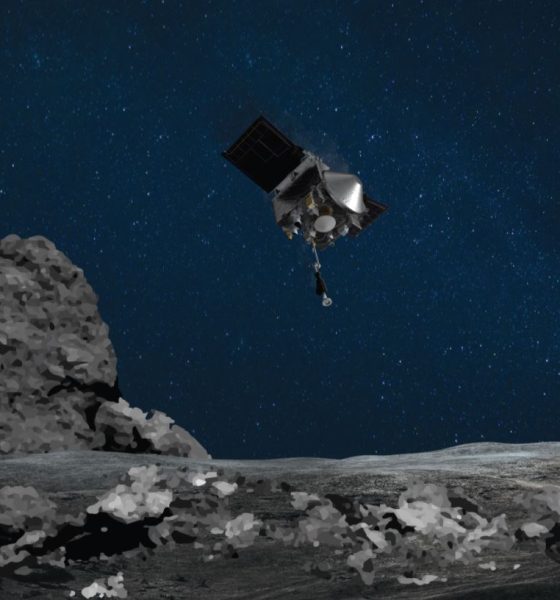

News
NASA prepares to collect asteroid samples next week in deep space OSIRIS-REx mission
NASA currently has an orbiter circling the asteroid Bennu about 200 million miles from Earth, and a live streamed attempt to collect a sample from its surface will be made next week.
The mission, OSIRIS-REx (Origins, Spectral Interpretation, Resource Identification, Security-Regolith Explorer), was developed to help improve our understanding of asteroid impact risks and study how planets and life in the universe began. After a two-year-long journey through deep space, Bennu’s surface has been studied by the orbiter extensively since its arrival in 2018 in preparation for its historic mission. If successful, the craft will land on the asteroid and gather a 2.1 ounce sample that will be returned to our planet in 2023.
“Bennu contains material from the early solar system and may contain the molecular precursors to life and Earth’s oceans,” NASA’s announcement of the live stream detailed. “The asteroid is about as tall as the Empire State Building and could potentially threaten Earth late in the next century, with a 1‐in‐2,700 chance of impacting our planet during one of its close approaches.”
NASA’s live web cast of the event will begin at 6:12 pm EDT on Tuesday, October 20th. Press briefings and other social media activities will be held on October 19th beginning at 1 pm EDT.
All right. Time to get in the zone… On TAG day I need to collect at least 2 oz (60 grams) of Bennu's surface material, but there's a chance I could collect up to 4.4 lbs (2 kg) 😱 guess we'll have to wait and see… it's all part of the journey #ToBennuAndBack pic.twitter.com/c8EgYofjrA
— NASA's OSIRIS-REx (@OSIRISREx) October 14, 2020
OSIRIS-REx, which is about 20 feet long and 10 feet high with its solar panels extended, has a two-part system to collect its asteroid sample. The first, a Touch-And-Go Sample Acquisition Mechanism (TAGSAM), is an articulated robotic arm with a sampler head that extends to the surface to gather regolith. Second, a Sample Return Capsule (SRC), acts as a container with a heat shield and parachutes that will both protect the asteroid regolith and enable reentry into Earth’s atmosphere. The mission is the first of its kind for NASA. Its predecessor is Japan’s Hayabusa mission which returned from with its asteroid sample in 2010.
TAG is six days away. I repeat TAG is SIX days away!
Mark your calendars and join me and my team for the adventure on Oct 20. The live broadcast starts at 5:00 pm EDT and touch down is scheduled for 6:12 pm EDT.
More details and events here: https://t.co/GZmHW4lV2C pic.twitter.com/4aLUPGX4gP
— NASA's OSIRIS-REx (@OSIRISREx) October 14, 2020
NASA has been hard at work over the last decade with its deep space missions. Most recently, the agency’s Insight lander has been making progress studying “Marsquakes” after arriving on Mars in 2018. The newest Mars rover, Perseverance, is en route to the red planet where it will collect a sample of its own from the surface to return to Earth in a future mission. That mission also includes the first rotary craft experiment that will attempt flight on another planet.
Another mission similar to OSIRIS-REx is NASA’s DART (Double Asteroid Redirection Test) spacecraft, scheduled to launch aboard a SpaceX Falcon 9 rocket in July 2021. DART will crash into the asteroid Didymos in 2022, and a European Space Agency orbiter will head to the asteroid in 2023 to study the event’s effects on the space object. Collected data will help formulate planetary defense plans by providing detailed analysis from DART’s real-time asteroid deflection experiment.

News
Tesla FSD v14.2.2 is getting rave reviews from drivers
So far, early testers have reported buttery-smooth drives with confident performance, even at night or on twisty roads.

Tesla Full Self-Driving (Supervised) v14.2.2 is receiving positive reviews from owners, with several drivers praising the build’s lack of hesitation during lane changes and its smoother decision-making, among others.
The update, which started rolling out on Monday, also adds features like dynamic arrival pin adjustment. So far, early testers have reported buttery-smooth drives with confident performance, even at night or on twisty roads.
Owners highlight major improvements
Longtime Tesla owner and FSD user @BLKMDL3 shared a detailed 10-hour impression of FSD v14.2.2, noting that the system exhibited “zero lane change hesitation” and “extremely refined” lane choices. He praised Mad Max mode’s performance, stellar parking in locations including ticket dispensers, and impressive canyon runs even in dark conditions.
Fellow FSD user Dan Burkland reported an hour of FSD v14.2.2’s nighttime driving with “zero hesitations” and “buttery smooth” confidence reminiscent of Robotaxi rides in areas such as Austin, Texas. Veteran FSD user Whole Mars Catalog also demonstrated voice navigation via Grok, while Tesla owner Devin Olsen completed a nearly two-hour drive with FSD v14.2.2 in heavy traffic and rain with strong performance.
Closer to unsupervised
FSD has been receiving rave reviews, even from Tesla’s competitors. Xpeng CEO He Xiaopeng, for one, offered fresh praise for FSD v14.2 after visiting Silicon Valley. Following extended test drives of Tesla vehicles running the latest FSD software, He stated that the system has made major strides, reinforcing his view that Tesla’s approach to autonomy is indeed the proper path towards autonomy.
According to He, Tesla’s FSD has evolved from a smooth Level 2 advanced driver assistance system into what he described as a “near-Level 4” experience in terms of capabilities. While acknowledging that areas of improvement are still present, the Xpeng CEO stated that FSD’s current iteration significantly surpasses last year’s capabilities. He also reiterated his belief that Tesla’s strategy of using the same autonomous software and hardware architecture across private vehicles and robotaxis is the right long-term approach, as it would allow users to bypass intermediate autonomy stages and move closer to Level 4 functionality.
News
Elon Musk’s Grok AI to be used in U.S. War Department’s bespoke AI platform
The partnership aims to provide advanced capabilities to 3 million military and civilian personnel.

The U.S. Department of War announced Monday an agreement with Elon Musk’s xAI to embed the company’s frontier artificial intelligence systems, powered by the Grok family of models, into the department’s bespoke AI platform GenAI.mil.
The partnership aims to provide advanced capabilities to 3 million military and civilian personnel, with initial deployment targeted for early 2026 at Impact Level 5 (IL5) for secure handling of Controlled Unclassified Information.
xAI Integration
As noted by the War Department’s press release, GenAI.mil, its bespoke AI platform, will gain xAI for the Government’s suite of tools, which enable real-time global insights from the X platform for “decisive information advantage.” The rollout builds on xAI’s July launch of products for U.S. government customers, including federal, state, local, and national security use cases.
“Targeted for initial deployment in early 2026, this integration will allow all military and civilian personnel to use xAI’s capabilities at Impact Level 5 (IL5), enabling the secure handling of Controlled Unclassified Information (CUI) in daily workflows. Users will also gain access to real‑time global insights from the X platform, providing War Department personnel with a decisive information advantage,” the Department of War wrote in a press release.
Strategic advantages
The deal marks another step in the Department of War’s efforts to use cutting-edge AI in its operations. xAI, for its part, highlighted that its tools can support administrative tasks at the federal, state and local levels, as well as “critical mission use cases” at the front line of military operations.
“The War Department will continue scaling an AI ecosystem built for speed, security, and decision superiority. Newly IL5-certified capabilities will empower every aspect of the Department’s workforce, turning AI into a daily operational asset. This announcement marks another milestone in America’s AI revolution, and the War Department is driving that momentum forward,” the War Department noted.
News
Tesla FSD (Supervised) v14.2.2 starts rolling out
The update focuses on smoother real-world performance, better obstacle awareness, and precise end-of-trip routing, among other improvements.

Tesla has started rolling out Full Self-Driving (Supervised) v14.2.2, bringing further refinements to its most advanced driver-assist system. The new FSD update focuses on smoother real-world performance, better obstacle awareness, and precise end-of-trip routing, among other improvements.
Key FSD v14.2.2 improvements
As noted by Not a Tesla App, FSD v14.2.2 upgrades the vision encoder neural network with higher resolution features, enhancing detection of emergency vehicles, road obstacles, and human gestures. New Arrival Options let users select preferred drop-off styles, such as Parking Lot, Street, Driveway, Parking Garage, or Curbside, with the navigation pin automatically adjusting to the user’s ideal spot for precision.
Other additions include pulling over for emergency vehicles, real-time vision-based detours for blocked roads, improved gate and debris handling, and extreme Speed Profiles for customized driving styles. Reliability gains cover fault recovery, residue alerts on the windshield, and automatic narrow-field camera washing for new 2026 Model Y units.
FSD v14.2.2 also boosts unprotected turns, lane changes, cut-ins, and school bus scenarios, among other things. Tesla also noted that users’ FSD statistics will be saved under Controls > Autopilot, which should help drivers easily view how much they are using FSD in their daily drives.
Key FSD v14.2.2 release notes
Full Self-Driving (Supervised) v14.2.2 includes:
- Upgraded the neural network vision encoder, leveraging higher resolution features to further improve scenarios like handling emergency vehicles, obstacles on the road, and human gestures.
- Added Arrival Options for you to select where FSD should park: in a Parking Lot, on the Street, in a Driveway, in a Parking Garage, or at the Curbside.
- Added handling to pull over or yield for emergency vehicles (e.g. police cars, fire trucks, ambulances).
- Added navigation and routing into the vision-based neural network for real-time handling of blocked roads and detours.
- Added additional Speed Profile to further customize driving style preference.
- Improved handling for static and dynamic gates.
- Improved offsetting for road debris (e.g. tires, tree branches, boxes).
- Improve handling of several scenarios, including unprotected turns, lane changes, vehicle cut-ins, and school buses.
- Improved FSD’s ability to manage system faults and recover smoothly from degraded operation for enhanced reliability.
- Added alerting for residue build-up on interior windshield that may impact front camera visibility. If affected, visit Service for cleaning!
- Added automatic narrow field washing to provide rapid and efficient front camera self-cleaning, and optimize aerodynamics wash at higher vehicle speed.
- Camera visibility can lead to increased attention monitoring sensitivity.
Upcoming Improvements:
- Overall smoothness and sentience.
- Parking spot selection and parking quality.








